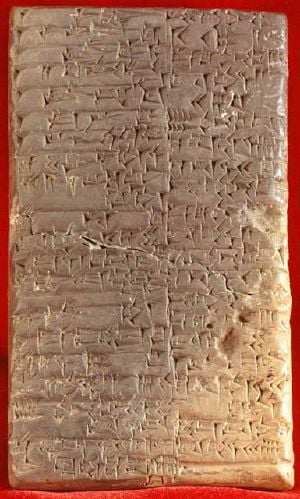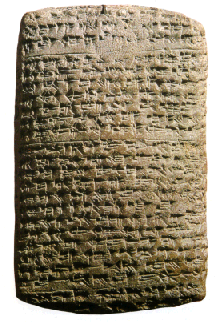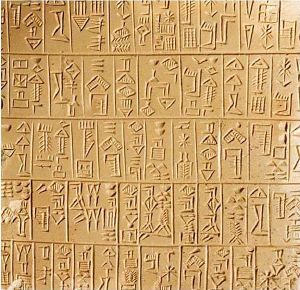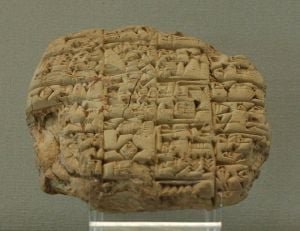Cuneiform script
| This article contains special characters. Without proper rendering support, you may see question marks, boxes, or other symbols. |
| Cuneiform | ||
|---|---|---|
| Type: | Logographic and syllabic | |
| Languages: | Akkadian, Eblaite, Elamite, Hattic, Hittite, Hurrian, Luwian, Sumerian, Urartian | |
| Time period: | ca. 30th century B.C.E. to 1st century C.E. | |
| Parent writing systems: | (Proto-writing) Cuneiform | |
| Child writing systems: | Old Persian, Ugaritic | |
| Unicode range: | U+12000 to U+1236E (Sumero-Akkadian Cuneiform) U+12400 to U+12473 (Numbers) | |
| ISO 15924 code: | Xsux | |
| Note: This page may contain IPA phonetic symbols in Unicode. | ||
The cuneiform script (kjuːˈniːəfɔrm) is the earliest known form of written expression. Created by the Sumerians from ca. 3000 B.C.E., cuneiform writing began as a system of pictographs. Over time, the pictorial representations became simplified and more abstract.[1]
Cuneiforms were written on clay tablets, on which symbols were drawn with a blunt reed for a stylus. The impressions left by the stylus were wedge shaped, thus giving rise to the name cuneiform ("wedge shaped").
The Sumerian script was adapted for the writing of the Akkadian, Elamite, Hittite (and Luwian), Hurrian (and Urartian) languages, and it inspired the Old Persian and Ugaritic national alphabets.
Etymology
The term cuneiform was coined in the 17th century, originally a French word that combined the Latin cuneus, which translates as "a wedge" with the French forme, to create cunéiforme, which literally translates as "wedge of unknown origin", which reflected the early confusion of who had created the many ancient writings European travelers had come across.[2] Later it was added to English as cuneiform.
History
The cuneiform writing system originated perhaps around 3000 B.C.E.[3] in Sumer; its latest surviving use is dated to 75 C.E. [4]
The cuneiform script underwent considerable changes over a period of more than two millennia. The image below shows the development of the sign SAG "head" (Borger nr. 184, U+12295).
Stage 1 shows the pictogram as it was drawn around 3000 B.C.E. Stage 2 shows the rotated pictogram as written around 2800 B.C.E. Stage 3 shows the abstracted glyph in archaic monumental inscriptions, from ca. 2600 B.C.E., and stage 4 is the sign as written in clay, contemporary to stage 3. Stage 5 represents the late 3rd millennium, and stage 6 represents Old Assyrian ductus of the early 2nd millennium, as adopted into Hittite. Stage 7 is the simplified sign as written by Assyrian scribes in the early 1st millennium, and until the script's extinction.
Pictograms
Originally, pictograms were drawn on clay tablets in vertical columns with a pen made from a sharpened reed stylus, or incised in stone. This early style lacked the characteristic wedge-shape of the strokes.[5]
Certain signs to indicate names of gods, countries, cities, vessels, birds, trees, etc., are known as "determinants," and were the Sumerian signs of the terms in question, added as a guide for the reader. Proper names continued to be usually written in purely "ideographic" fashion.[6]
From about 2900 B.C.E., many pictographs began to lose their original function, and a given sign could have various meanings depending on context. The sign inventory was reduced from some 1,500 signs to some 600 signs, and writing became increasingly phonological. Determinative signs were re-introduced to avoid ambiguity.[6]
Archaic cuneiform
In the mid-3rd millennium, writing direction was changed to left to right in horizontal rows (rotating all of the pictograms 90° counter-clockwise in the process), and a new wedge-tipped stylus was used which was pushed into the clay, producing wedge-shaped ("cuneiform") signs; these two developments made writing quicker and easier. By adjusting the relative position of the tablet to the stylus, the writer could use a single tool to make a variety of impressions. The word "cuneiform" comes from the Latin word cuneus, meaning "wedge."[7]
Cuneiform tablets could be fired in kilns to provide a permanent record, or they could be recycled if permanence was not needed. Many of the clay tablets found by archaeologists were preserved because they were fired when attacking armies burned the building in which they were kept.
The script was also widely used on commemorative stelae and carved reliefs to record the achievements of the ruler in whose honour the monument had been erected.
Akkadian cuneiform
The archaic cuneiform script was adopted by the Akkadians from ca. 2500 B.C.E., and by 2000 B.C.E., had evolved into Old Assyrian cuneiform, with many modifications to Sumerian orthography. The Semitic equivalents for many signs became distorted or abbreviated to form new "phonetic" values, because the syllabic nature of the script as refined by the Sumerians was unintuitive to Semitic speakers.[8]
At this stage, the former pictograms were reduced to a high level of abstraction, and were composed of only five basic wedge shapes: horizontal, vertical, two diagonals and the Winkelhaken impressed vertically by the tip of the stylus.[9]


"Typical" signs have usually in the range of about five to ten wedges, while complex ligatures can consist of twenty or more (although it is not always clear if a ligature should be considered a single sign or two collated but still distinct signs); the ligature KAxGUR7 consists of 31 strokes.
Most later adaptations of Sumerian cuneiform preserved at least some aspects of the Sumerian script. Written Akkadian included phonetic symbols from the Sumerian syllabary, together with logograms that were read as whole words. Many signs in the script were polyvalent, having both a syllabic and logographic meaning.[10]
Assyrian cuneiform
This "mixed" method of writing continued through the end of the Babylonian and Assyrian empires, although there were periods when "purism" was in fashion and there was a more marked tendency to spell out the words laboriously, in preference to using signs with a phonetic complement. Yet even in those days, the Babylonian syllabary remained a mixture of ideographic and phonetic writing.[6]
Hittite cuneiform is an adaptation of the Old Assyrian cuneiform of ca. 1800 B.C.E. to the Hittite language. When the cuneiform script was adapted to writing Hittite, a layer of Akkadian logographic spellings was added to the script, with the result that we no longer know the pronunciations of many Hittite words conventionally written by logograms.
In the Iron Age (ca. 10th to 6th c. BC), Assyrian cuneiform was further simplified. From the 6th century, the Assyrian language was marginalized by Aramaic, written in the Aramaean alphabet, but Neo-Assyrian cuneiform remained in use in literary tradition well into Parthian times.[6]
Derived scripts
The complexity of the system prompted the development of a number of simplified versions of the script. Old Persian was written in a subset of simplified cuneiform characters known today as Old Persian cuneiform. It formed a semi-alphabetic syllabary, using far fewer wedge strokes than Assyrian used, together with a handful of logograms for frequently occurring words like "god" and "king." The Ugaritic language was written using the Ugaritic alphabet, a standard Semitic style alphabet (an abjad) written using the cuneiform method. However, the brief influence cuneiform had died away quickly, and was completely abandoned as a style around the end of the 6th century, as other styles of written language populated the region. Like the Ancient Egyptian language, cuneiform died as a langauge and remained a mystery to many people until scholars in the 19th century worked to decipher it.
Decipherment
Early European travelers to Persepolis (Iran) noticed carved cuneiform inscriptions and were intrigued, yet it was not until 1835 when Henry Rawlinson, a British East India Company army officer, visited the Behistun inscriptions in Persia that a breakthrough in understanding was made. Carved in the reign of King Darius of Persia (522 B.C.E.–486 B.C.E.), they consisted of identical texts in the three official languages of the empire: Old Persian, Babylonian, and Elamite.[11]The Behistun inscription was to the decipherment of cuneiform what the Rosetta Stone was to the decipherment of Egyptian hieroglyphs.
Rawlinson correctly deduced that the Old Persian was a phonetic script and he successfully deciphered it. After translating the Persian, Rawlinson and, working independently of him, the Anglo-Irish Egyptologist Edward Hincks, began to decipher the others. (The actual techniques used to decipher the Akkadian language have never been fully published; Hincks described how he sought the proper names already legible in the deciphered Persian while Rawlinson never said anything at all, leading some to speculate that he was secretly copying Hincks.[12] They were greatly helped by Paul Émile Botta's discovery of the city of Nineveh in 1842. Among the treasures uncovered by Botta were the remains of the great library of Assurbanipal, a royal archive containing tens of thousands of baked clay tablets covered with cuneiform inscriptions.
By 1851, Hincks and Rawlinson could read 200 Babylonian signs.[13] They were soon joined by two other decipherers: young German-born scholar Julius Oppert, and versatile British Orientalist William Henry Fox Talbot. In 1857 the four men met in London and took part in a famous experiment to test the accuracy of their decipherments, in which Hincks and Rawlison proved the winners.
In the early days of cuneiform decipherment, the reading of proper names presented the greatest difficulties. However, there is now a better understanding of the principles behind the formation and the pronunciation of the thousands of names found in historical records, business documents, votive inscriptions and literary productions. The primary challenge was posed by the characteristic use of old Sumerian non-phonetic ideograms in other languages that had different pronunciations for the same symbols. Until the exact phonetic reading of many names was determined through parallel passages or explanatory lists, scholars remained in doubt, or had recourse to conjectural or provisional readings. Fortunately, in many cases, there are variant readings, the same name being written phonetically (in whole or in part) in one instance, and ideographically in another.
Notes
- ↑ (1996) Hooker, Richard."World Civilizations" "Cuneiform" Retrieved July 9, 2008
- ↑ cuneiform. (n.d.). Online Etymology Dictionary. Retrieved July 09, 2008, from Dictionary.com website: http://dictionary.reference.com/browse/cuneiform
- ↑ Kramer, Samuel Noah Thirty Nine Firsts In Recorded History University of Pennsylvania 1998 ISBN 0812212762
- ↑ Adkins, Lesley. Empires of the Plain, HarperCollins 2003, ISBN 0 00 712899 1
- ↑ (1996) Hooker, Richard."World Civilizations" "Cuneiform" Retrieved July 9, 2008
- ↑ 6.0 6.1 6.2 6.3 Marc Van de Mieroop, Cuneiform Texts and the Writing of History (Routledge, 1999, ISBN 0415195330)
- ↑ (2007) Lo, Lawrence. Ancient Scripts.com "Cuneiform" Retrieved July 9, 2008
- ↑ (2007) Lo, Lawrence. Ancient Scripts.com "Cuneiform" Retrieved July 9, 2008
- ↑ (1996) Hooker, Richard."World Civilizations" "Cuneiform" Retrieved July 9, 2008
- ↑ (2007) Lo, Lawrence. Ancient Scripts.com "Cuneiform" Retrieved July 9, 2008
- ↑ (2007) Hinderscheit, Jinnie. E-Museum @ Minnesota State University, Mankato "Sir Henry Creswicke Rawlinson:1810-1895" Retrieved July 10, 2008
- ↑ Peter Daniels and William Bright (eds.), The World's Writing Systems (Oxford University Press, 1996, ISBN 0195079930)
- ↑ (2007) Hinderscheit, Jinnie. E-Museum @ Minnesota State University, Mankato "Sir Henry Creswicke Rawlinson:1810-1895" Retrieved July 10, 2008
ReferencesISBN links support NWE through referral fees
- R. Borger, Assyrisch-Babylonische Zeichenliste, 2nd ed., Neukirchen-Vluyn (1981)
- R. Borger, Mesopotamisches Zeichenlexikon, Münster (2003). [1]
- A. Deimel, Liste der archaischen Keilschriftzeichen (WVDOG 40; Berlin 1922) [2]
- F. Ellermeier, M. Studt, Sumerisches Glossar
- vol. 1: 1979-1980, ISBN 3-921747-08-2, ISBN 3-921747-10-4
- vol. 3.2: 1998-2005, A-B ISBN 3-921747-24-4, D-E ISBN 3-921747-25-2, G ISBN 3-921747-29-5
- vol. 3.3: ISBN 3-921747-22-8 (font CD ISBN 3-921747-23-6)
- vol. 3.5: ISBN 3-921747-26-0
- vol 3.6: 2003, Handbuch Assur ISBN 3-921747-28-7
- A. Falkenstein, Archaische Texte aus Uruk, Berlin-Leipzig (1936) [3]
- E. Forrer, Die Keilschrift von Boghazköi, Leipzig (1922)
- J. Friedrich, Hethitisches Keilschrift-Lesebuch, Heidelberg (1960)
- Jean-Jacques Glassner, The Invention of Cuneiform, English translation, Johns Hopkins University Press (2003), ISBN 0-8018-7389-4.
- René Labat, Manuel d'epigraphie Akkadienne, Geuthner, Paris (1959); 6th ed., extended by Florence Malbran-Labat (1999), ISBN 2-7053-3583-8.
- O. Neugebauer, A. Sachs (eds.), Mathematical Cuneiform Texts, New Haven (1945).
- Y. Rosengarten, Répertoire commenté des signes présargoniques sumériens de Lagash, Paris (1967) [4]
- Chr. Rüster, E. Neu, Hethitisches Zeichenlexikon (HZL), Wiesbaden (1989)
- Nikolaus Schneider, Die Keilschriftzeichen der Wirtschaftsurkunden von Ur III nebst ihren charakteristischsten Schreibvarianten, Keilschrift-Paläographie; Heft 2, Rom: Päpstliches Bibelinstitut (1935). [5]
- Wolfgang Schramm, Akkadische Logogramme, Goettinger Arbeitshefte zur Altorientalischen Literatur (GAAL) Heft 4, Goettingen (2003), ISBN 3-936297-01-0.
- F. Thureau-Dangin, Recherches sur l'origine de l'écriture cunéiforme, Paris (1898).
- Ronald Herbert Sack, Cuneiform Documents from the Chaldean and Persian Periods, (1994) ISBN 0945636679
- Van de Mieroop, Marc. Cuneiform Texts and the Writing of History. Routledge, 1999. ISBN 0415195330
- Daniels, Peter, and William Bright (eds.). The World's Writing Systems. Oxford University Press, 1996. ISBN 0195079930
- Kramer, Samuel Noah. Thirty Nine Firsts In Recorded History. University of Pennsylvania, 1998. ISBN 0812212762
External links
- Online Translator - Translates English words, sentences, and phrases into ancient Assyrian, Babylonian, Sumerian cuneiform
- Budge, E.A. Cuneiform Texts from Babylonian Tablets, &c. in the British Museum London, Harrison and Sons, 1896.
- Cuneiform Digital Library Initiative. A Joint Project of the University of California at Los Angeles and the Max Planck Institute for the History of Science.
- Online interactive cuneiform tablet from the State Library of Victoria collection.
- ETCSL sign list
- Evolution of Cuneiform
- Akkadian sign list (alain.be)
- Digital encoding and rendering
- cuneiformsigns.org Analysis and reports to support an international standard for computer encoding of the Cuneiform writing system
- iClay Java applet for the "interactive viewing of 2D+ images of cuneiform tablets over the Internet"
- Fonts
- Unicode
- Akkadian (reproduces the archaic (Ur III) glyphs given in the Unicode reference chart, themselves based on a font by Steve Tinney)
- A free Cuneiform font, Cuneiform Composite, also Ur III. Designed by Steve Tinney with input from Michael Everson.
- non-Unicode
- Cuneiform fonts for TeX/LaTeX/PDFLaTeX by Karel Piska (Type 1, GPL)
- Ullikummi (Hittite package) by Sylvie Vanséveren (TrueType, freeware)
- UR III font by Guillaume Malingue (TrueType, freeware)
Credits
New World Encyclopedia writers and editors rewrote and completed the Wikipedia article in accordance with New World Encyclopedia standards. This article abides by terms of the Creative Commons CC-by-sa 3.0 License (CC-by-sa), which may be used and disseminated with proper attribution. Credit is due under the terms of this license that can reference both the New World Encyclopedia contributors and the selfless volunteer contributors of the Wikimedia Foundation. To cite this article click here for a list of acceptable citing formats.The history of earlier contributions by wikipedians is accessible to researchers here:
The history of this article since it was imported to New World Encyclopedia:
Note: Some restrictions may apply to use of individual images which are separately licensed.




